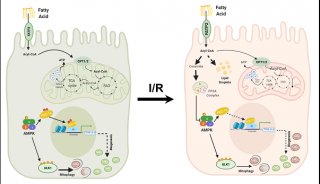线粒体的结构与功能
In an attempt to be concise and understandable, introductory level courses and textbooks frequently present concepts that are technically correct, but lead to misconceptions on the part of the student because they omit too much. In discussions about mitochondria students frequently come away with a superficial understanding of the true nature of Krebs' cycle, electron transport, respiratory control, and oxidative phosphorylation.
These pages were designed to supplement laboratory work with mitochondria by providing background in as much detail as the student might wish. Students at any level are likely to encounter terms with which they are unfamiliar. A glossary of terms is included in this project for your convenience. A brief overview of mitochondria structure and function is presented just to get you started. You can then wind your way through the main path of detailed information.
Structure
Mitochondria are bacteria-sized organelles, found in the cytoplasm of virtually all eukaryotic cells. They are especially abundant in cells and parts of cells that are associated with active processes. For example, in flagellated protozoa or in mammalian sperm, mitochondria are concentrated around the base of the flagellum or flagella. In cardiac muscle, mitochondria surround the contractile elements. Hummingbird flight muscle is one of the richest sources of mitochondria known. Thus, from their distribution alone one suspects that they are involved in energy production.
We know now that multicellular organisms probably could not exist without mitochondria. Mitochondria make efficient use of nutrient molecules, requiring oxygen in the process. They are, in fact, why we need oxygen at all.
The double-membraned mitochondrion can be loosely described as a large wrinkled bag packed inside of a smaller, unwrinkled bag. The two membranes create distinct compartments within the organelle, and are themselves very different in structure and in function.
The outer membrane is a relatively simple phospholipid bilayer, containing protein structures called porins which render it permeable to molecules of about 10 kilodaltons or less (the size of the smallest proteins). Ions, nutrient molecules, ATP, ADP, etc. can pass through the outer membrane with ease.
The inner membrane is freely permeable only to oxygen, carbon dioxide, and water. Its structure is highly complex, including all of the complexes of the electron transport system, the ATP synthetase complex, and transport proteins. The wrinkles, or folds, are organized into lamillae (layers), called the cristae (singlular: crista). The cristae greatly increase the total surface area of the inner membrane. The larger surface area makes room for many more of the above-named structures than if the inner membrane were shaped like the outer membrane.
The membranes create two compartments. The intermembrane space, as implied, is the region between the inner and outer membranes. It has an important role in the primary function of mitochondria, which is oxidative phosphorylation.
The matrix contains the enzymes that are responsible for the citric acid cycle reactions. The matrix also contains dissolved oxygen, water, carbon dioxide, the recyclable intermediates that serve as energy shuttles, and much more. Because of the folds of the cristae, no part of the matrix is far from the inner membrane. Therefore matrix components can quickly reach inner membrane complexes and transport proteins.
Electron micrographs have revealed the three dimensional structure of mitochondria. However, since micrographs are themselves two dimensional, their interpretation can be misleading.
Texts frequently show a picture of a 'typical' mitochondrion as a bacteria-sized ellipsoid (perhaps 0.5 by 1 micrometer). However, they vary widely in shape and size. Electron micrographs seldom show such variation, because they are two-dimensional images.
Isolated mitochondria, such as from homogenized muscle tissue, show a rounded appearance in electron micrographs, implying that mitochondria are spherical organelles.
Mitochondria in situ can be free in the cytoplasm or packed in among more rigid structures, such as among the myofibrils of cardiac muscle tissue. In cells such as muscle, it is clear that mitochondria are not spherical, and often are not even ellipsoid. In some tissues, the mitochondria are almost filamentous, a characteristic that two dimensional micrographs may fail to reveal.
A planar section cuts through one or several parts of the organelle, making it appear that there is more than one. The image we see of a circular or ellipsoidal organelle may disguise the true nature of the mitochondrion.
-
科技前沿









